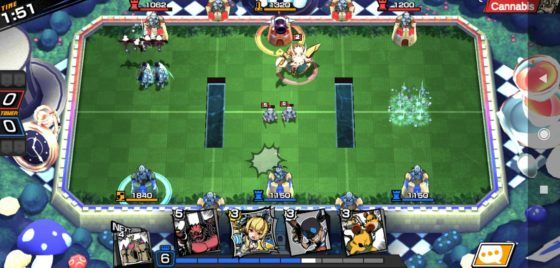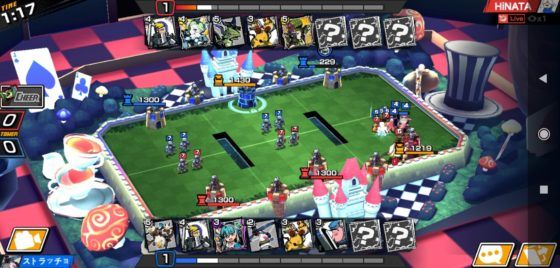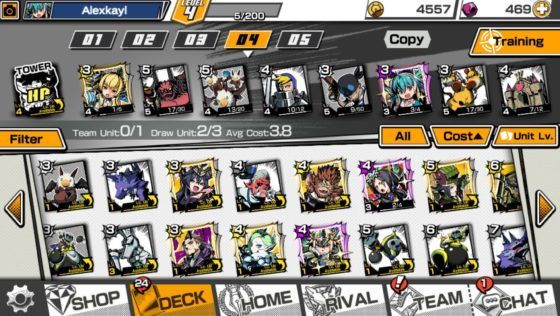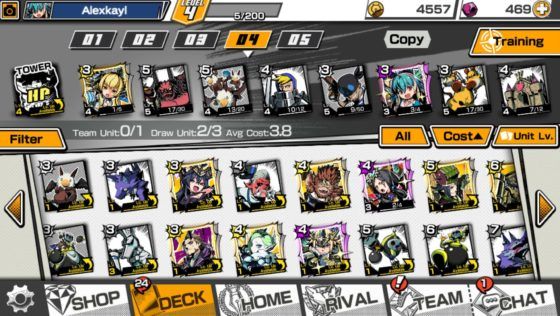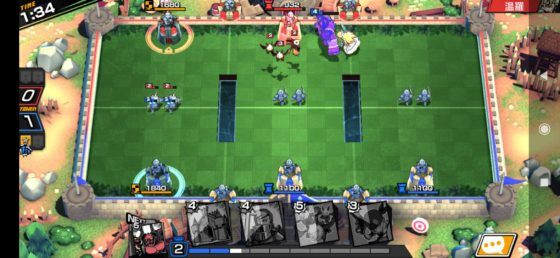The first minutes on League of Wonderland felt like déjà vu all over again. Sega’s new mobile game unfolds like any other run-of-the-mill Clash Royale game amidst a sea of clones, carefully engineered to appeal to diehard fans of the tower defense genre. It tries to tick all the right boxes, but nowadays you must bring something new to convince players that it’s worthwhile switching to your game.
The least that we can say is that League of Wonderland tries to add something to the mix, although with moderate success. The gimmick here is the draw shot, a feature that sounds great on paper, but it doesn’t drastically change the face of the game as much as it was supposed to. Nonetheless, it’s a clever idea in a game that otherwise would just look and play like every other Clash Royale clone.
League of Alice and her imaginary friends
The cast of League of Wonderland is so wide-ranging that it almost feels random and consequently uninspired. With such a rich heritage to draw inspiration from, Sega instead decided to pick heroes from fairy tales, myths, and history. It’s a choice that is bound to get many players scratching their heads, and sounds like a hard-sell – all of you who are dying to see a clash between Alice and Zeus, put your hand in the air. It’s just downright weird, and if they could do it for Sega Heroes, why not go for the same approach with League of Sega… I mean, League of Wonderland?
After many hours of clashes, I still didn’t find anyone from the cast particularly compelling. It wasn’t a problem with the art style, or a lack of detail; they just failed to catch my attention. The griffins, mice, and assorted historical figures just didn’t resonate with me, but it may be up to personal taste.
On the other hand, the gameplay grew on me and my brain unconsciously kept sending me messages of ‘just one more go.’ The matches only last two minutes, although there is overtime if the match is tied when the clock reaches zero. A large part of the appeal comes from the fast-paced bite-sized matches, and that is why the genre still sees plenty of new releases every year.
The winning conditions are as simple as they come – destroy two of the three enemy towers and you’ll secure the win. Each of your towers spawn a couple of minions every few seconds, but it’s up to you to use a deck of eight cards to deal the most damage. You have land and air units based on a simple rock-paper-scissors mechanic, but it’s easier said than done.
At its core, League of Wonderland plays just like every other Clash Royale clone, but it comes with a nice twist: draw shots. Some of your heroes have a special ability where you use your finger to trace it across the mobile screen. Some draw shots can only be used in a straight line, but others allow free movement, in order to hit several enemy units at a time. It’s a nice gimmick that adds depth to the gameplay, with some draw shots effectively changing the tide of battle.
If it weren’t for the inclusion of the draw shots, League of Wonderland would play just like every other Clash Royale game, albeit one that is polished and flawless. It heavily relies upon the traditional progress system of the genre, with points earned in every match contributing to your overall rank, as you climb league after league. Cards grow their experience levels the more you use them, and can be upgraded by spending the mandatory gold fee. There are chests raining everywhere with cards and gold, but you need to use keys or rubies to open them; otherwise, you’re in for a few hours of waiting before the best chests reveal their precious contents. The game seems fairly generous at the moment, so here’s hoping that Sega won’t flip a switch and make it much harder to earn cards and currency.
Cheerleading Your Way to the Top
This kind of game is always prone to some weird matchmaking, but League of Wonderland’s system never felt like it was randomly throwing players together. Most of the matches were evenly balanced for tower and minion strength, providing some exciting and fair clashes.
One of the most annoying things about the game is how some players are already gaming the system in infuriating ways. While you’re trying to focus on your strategy and the cards that you need to use, the chat system unexpectedly pops up and obscures half of the playing field, undermining your move and most likely the entire match. You must click a message or emote to make it go away, but your stubborn rival insists on this shameless tactic and takes the win. This requires an urgent fix, and some sort of ban for the infringing players would have my full approval.
Besides progress by playing, you can also use cheer tickets to earn rewards. You pick the player from a match that you think is going to win, placing your bet and hopefully earning some in-game currency if your prediction was right on the money.
Gameplay: 7/10
League of Wonderland grows on you, showing that the tried-and-test tower defense gameplay remains addictive after all these years. While first impressions aren’t the greatest, there are small details contributing to a compelling PvP challenge that you can play for a few minutes or hours on end.
The draw shots are the standout feature, adding another layer to a traditionally rich and tactically demanding genre. With dozens of cards to unlock and evolve, there is quite some experimentation to do if you plan on climbing the ranks.
Innovation: 4/10
League of Wonderland is a Clash Royale clone, period. Despite the sharp new dressings and the introduction of draw shots, everything about it feels derivative. This is a massive negative point if you’re on a relentless crusade for video game originality; otherwise, it’s just a minor footnote in a game that knows what it is trying to achieve.
Learning Curve: 8/10
If you’ve played any Clash Royale clone ever, you’ll be summoning units and destroying towers in no time. The only innovation here is the draw shot, and that is extremely simple to grasp.
Graphics / Sound: 8/10
The different battlefields are cute, and the art style has this cool anime zing to it, with detailed animations for the tiny units. Playing in landscape mode is nice for a change and allows for richer visuals. There is a full 3D mode that isn’t as intuitive as the default perspective, but it lets you rotate the arena as you wish, in order to admire the whole scenario.
The main menu soundtrack is so upbeat, so funky that you’re bound to shake your head to the rhythm, while cursing Sega for its vicious nature. The battle theme is of high quality as well, infectious and fun.
Value for Money: 7/10
League of Wonderland is free-to-play and currently generous with its card distribution. You’ll have quite a bit of fun before you eventually reach the point where you need to purchase booster packs and card packs to remain competitive.
Overall: 7/10
League of Wonderland seems overly familiar at first, but give it time and it will grab you with its addictive mechanics. The draw shot is a nice gimmick, but the game would benefit a lot from a more focused roster. League of Wonderland may be highly derivative, but it’s so effective that you end up ignoring the fact that you’ve played it several times before under a different guise, and just have fun with it.
Pros
Tried-and-test gameplay that is polished and fun
Draw shot is an unpretentious but interesting addition
Nice anime graphics and presentation
Catchy soundtrack
Cons
Derivative gameplay
Unfocused roster
